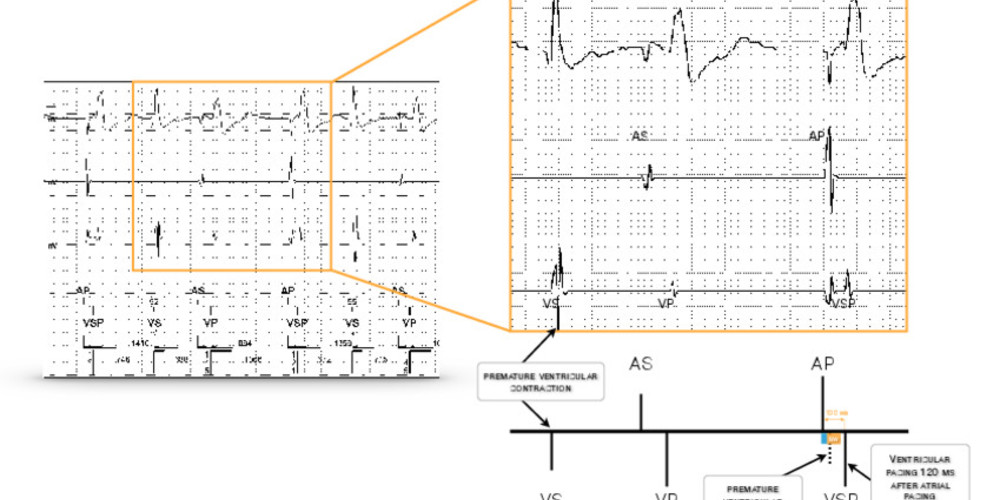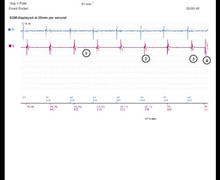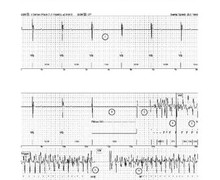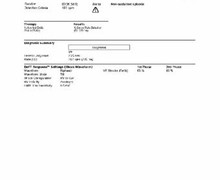post-atrial ventricular blanking and safety window
Tracing
Manufacturer Abbott
Device PM
Field AV delays, refractory periods management of tachycardia
N° 25
Patient
72-year-old man implanted for a complete atrioventricular block; recording of this tracing during the consultation.

Graph and trace
Patient with numerous premature ventricular contractions; AP-VSP cycles corresponding to a late premature ventricular contraction detected in the post-atrial ventricular safety window and leading to ventricular pacing 120 ms after the atrial pulse.

Other articles that may be of interest to you







The sensing of atrial activity does not trigger a refractory period in the ventricle, given the limited risk of far-field oversensing (low amplitude of intrinsic atrial signals in the ventricular cavity). However, following an atrial pacing, it is imperative to protect the ventricular cavity, the risk of crosstalk being substantial (pacing in Volts, sensing in mV with a ratio of 1 per 1000).
A ventricular blanking period is therefore triggered only after an atrial stimulus. This period is designed to prevent sensing of the atrial stimulus by the ventricular sensing chain which would lead to ventricular inhibition. A ventricular signal occurring during the post-atrial ventricular blanking (premature ventricular contraction, for example) is not sensed and therefore does not inhibit ventricular pacing occurring at the end of the programmed AV delay. This blanking is programmable to AUTO (Accent platform onward, nominal value) or to a fixed value between 12 and 52 ms. When AUTO programming is selected, if a ventricular signal falls during this blanking period, the blanking is automatically prolonged until a signal is no longer sensed or until the limit value of 52 ms.
The safety window is a supplementary ventricular sensing period of the post-atrial ventricular blanking. It is initiated only after atrial pacing and is designed to prevent a premature ventricular contraction due to inappropriate inhibition of ventricular pacing by sensing of the stimulus or of atrial depolarization subsequent to pacing. Ventricular sensing occurring after the post-atrial ventricular blanking but before the end of the safety window is considered non-physiological and causes ventricular pacing at the end of the safety window. If the event sensed in the safety window is the result of crosstalk or oversensed noise, the pacing pulse allows effective ventricular capture at the end of the safety window. If the event sensed in the safety window corresponds to a late premature ventricular contraction or atrioventricular conduction, the pacing at the end of the safety window occurs sufficiently early in the absolute myocardial ventricular refractory period to avoid pacing on at the peak of the T wave.
The safety window can be set to On or Off (nominal value On). If a ventricular signal is sensed in the safety window (begins after the post-atrial ventricular blanking period and ends 64 ms after the atrial stimulus), ventricular pacing is initiated 120 ms after atrial pacing. The short AV delay pattern (120 ms post-atrial pacing) and the VSP marker allow recognizing, on the EGM, when a safety ventricular pacing has been delivered.
When post-atrial ventricular blanking is programmed to Auto, this also has implications for the functioning of the safety window. Any ventricular signal falling during the initial blanking of 12 ms (possible crosstalk) triggers a succession of new re-triggerable 12 ms blanking periods until the sensing stops without exceeding a limit set at 52 ms; if ventricular sensing ends before this 52 ms limit, the crosstalk window is not required and is canceled (ventricular sensing occurring after the 52 ms limit and before the end of AV delay inhibits ventricular pacing); if ventricular sensing continues beyond this 52 ms limit, the safety window lasts 52 to 64 ms after atrial pacing; ventricular sensing in this window leads to ventricular pacing 120 ms after the atrial stimulus.